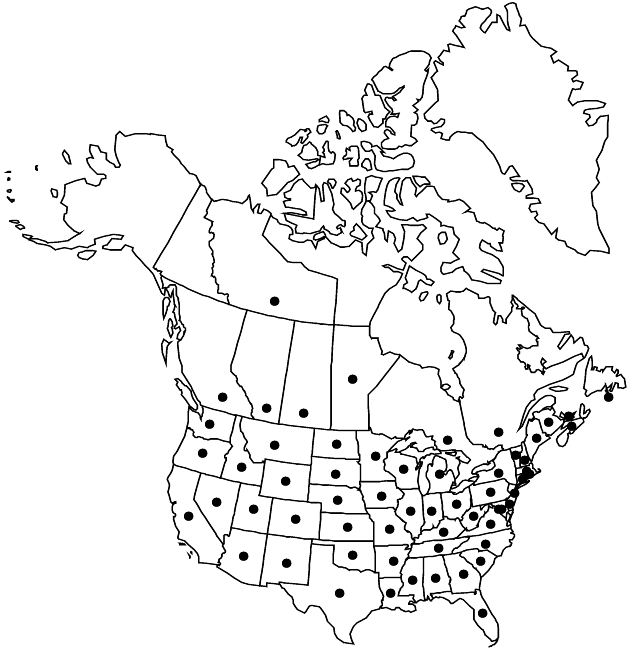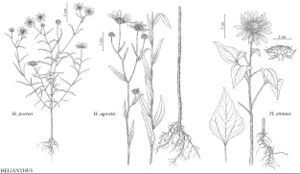Helianthus annuus
Sp. Pl. 2: 904. 1753.
Annuals, 100–300 cm. Stems erect, usually hispid. Leaves mostly cauline; mostly alternate; petioles 2–20 cm; blades lanceovate to ovate, 10–40 × 5–40 cm, bases cuneate to subcordate or cordate, margins serrate, abaxial faces usually ± hispid, sometimes glanddotted. Heads 1–9. Peduncles 2–20 cm. Involucres hemispheric or broader, 15–40 (–200+) mm diam. Phyllaries 20–30 (–100+), ovate to lanceovate, 13–25 × (3–) 5–8 mm, (margins usually ciliate) apices abruptly narrowed, long-acuminate, abaxial faces usually hirsute to hispid, rarely glabrate or glabrous, usually glanddotted. Paleae 9–11 mm, 3-toothed (middle teeth long-acuminate, glabrous or hispid). Ray-florets (13–) 17–30 (–100+); laminae 25–50 mm. Disc-florets 150+ (–1000+); corollas 5–8 mm (throats ± bulbous at bases), lobes usually reddish, sometimes yellow; anthers brownish to black, appendages yellow or dark (style-branches yellow). Cypselae (3–) 4–5 (–15) mm, glabrate; pappi of 2 lanceolate scales 2–3.5 mm plus 0–4 obtuse scales 0.5–1 mm. 2n = 34.
Phenology: Flowering summer–fall.
Habitat: Open areas
Elevation: 0–3000 m
Distribution

St. Pierre and Miquelon, Alta., B.C., Man., N.B., N.W.T., N.S., Ont., P.E.I., Que., Sask., Ala., Ariz., Ark., Calif., Colo., Conn., Del., D.C., Fla., Ga., Idaho, Ill., Ind., Iowa, Kans., Ky., La., Maine, Md., Mass., Mich., Minn., Miss., Mo., Mont., Nebr., Nev., N.H., N.J., N.Mex., N.Y., N.C., N.Dak., Ohio, Okla., Oreg., Pa., R.I., S.C., S.Dak., Tenn., Tex., Utah, Vt., Va., Wash., W.Va., Wis., Wyo., Mexico, intoduced nearly worldwide
Discussion
Helianthus annuus is widely distributed, including weedy, cultivated, and escaped plants. It is the only native North American species to become a major agronomic crop. Despite its considerable variability, attempts have failed to produce a widely adopted infraspecific system of classification. Forms with red-colored ray laminae, known from cultivation and occasionally seen escaped, trace their ancestry to a single original mutant plant. It hybridizes with many of the other annual species.
Selected References
None.
Lower Taxa
"broader" is not a number.
